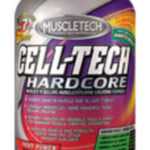During exercise, hydrolysis of adenosine triphosphate (ATP) to adenosine diphosphate (ADP) provides energy for muscles to contract and generate force for movement. As exercise continues, your body needs to regenerate ATP as without ATP, your muscles cannot contract and exercise activity will cease. The fastest mechanism your body uses to regenerate ATP is through the creatine phosphate system. This system is primarily used during high intensity exercise such as sprints or weight lifting in order to allow you to continue the high intensity activity, at least for a short period of time.
During high intensity exercise, your body uses ATP rapidly to generate a large amount of force. As a result, your body is left with significant amounts of ADP. In order to quickly regenerate ATP and maintain high intensity activities, an enzyme known as creatine kinase breaks down creatine phosphate to creatine and a free phosphate with a net release of energy. The resulting energy is used to regenerate ATP from ADP and another free phosphate. This allows the body to quickly regenerate ATP in muscles, and sustain the high level of ATP consumption needed for high intensity exercise.
The process is reversed to regenerate creatine phosphate. ATP is broken down to ADP and a free phosphate, of which the free energy is used to combine creatine and phosphate to form creatine phosphate. Again, the enzyme creatine kinase facilitates and speeds up this reaction. This results in creatine phosphate being replenished in your muscles.
This leads to a problem as ATP is required for both regenerating creatine phosphate and for muscle contraction. As the body cannot effectively do both at the same time during high intensity exercise, the body allows creatine phosphate levels to decline in order to use it to regenerate ATP for muscular contraction and force generation. As the exercise duration increases and creatine phosphate levels decline further, you ultimately experience fatigue as your body is unable to maintain high intensity exercise activity simply because your body is incapable of regenerating the high amounts of ATP needed to maintain the high intensity activity.
Creatine phosphate regenerates during recovery, or when the exercise intensity is low enough that ATP demand in the muscles has decreased to the point the body can use ATP to regenerate creatine phosphate. This is the reason you breathe strongly and deeply after running an all out sprint or lifting a really heavy weight as your body is using oxygen and oxidative respiration to create ATP and regenerate creatine phosphate.
In summary, creatine phosphate is your body’s immediate energy source and your body maintains just enough to sustain high intensity activities for a short period of time. Creatine phosphate simply acts as a temporary buffer to maintain muscular ATP levels to continue high intensity activity.






